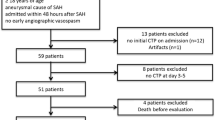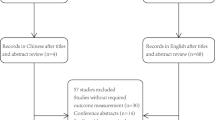Abstract
Introduction
Early identification of delayed cerebral ischemia (DCI) in patients with aneurysmal subarachnoid hemorrhage (aSAH) is a major challenge. The aim of this study was to investigate whether quantitative EEG (qEEG) features can detect DCI prior to clinical or radiographic findings.
Methods
A prospective cohort study was performed in aSAH patients in whom continuous EEG (cEEG) was recorded. We studied 12 qEEG features. We compared the time point at which qEEG changed with the time point that clinical deterioration occurred or new ischemia was noted on CT scan.
Results
Twenty aSAH patients were included of whom 11 developed DCI. The alpha/delta ratio (ADR) was the most promising feature that showed a significant difference in change over time in the DCI group (median −62 % with IQR −87 to −39 %) compared to the control group (median +27 % with IQR −32 to +104 %, p = 0.013). Based on the ROC curve, a threshold was chosen for a combined measure of ADR and alpha variability (AUC: 91.7, 95 % CI 74.2–100). The median time that elapsed between change of qEEG and clinical DCI diagnosis was seven hours (IQR −11–25). Delay between qEEG and CT scan changes was 44 h (median, IQR 14–117).
Conclusion
In this study, ADR and alpha variability could detect DCI development before ischemic changes on CT scan was apparent and before clinical deterioration was noted. Implementation of cEEG in aSAH patients can probably improve early detection of DCI.





Similar content being viewed by others
References
Suarez J, Tarr R, Selman W. Aneurysmal subarachnoid hemorrhage. N Engl J Med. 2006;354:387–96.
Koenig M. Management of delayed cerebral ischemia after subarachnoid hemorrhage. Continuum (Minneap Minn). 2012;18:579–97.
Dorsch N, King M. A review of cerebral vasospasm in aneurysmal subarachnoid haemorrhage. J Clin Neurosci. 1994;1:19–26.
Neil-Dwyer G, Lang D, Doshi B, Gerber C, Smith P. Delayed cerebral ischaemia: the pathological substrate. Acta Neurochir. 1994;131:137–45.
Rabinstein A, Weigand S, Atkinson J, Wijdicks E. Patterns of cerebral infarction in aneurysmal subarachnoid hemorrhage. Stroke. 2005;36:992–7.
Claassen J, Bernardini G, Kreiter K, et al. Effect of cisternal and ventricular blood on risk of delayed cerebral ischemia after subarachnoid hemorrhage: the Fisher scale revisited. Stroke. 2001;32:2012–20.
Murayama Y, Malisch T, Guglielmi G, et al. Incidence of cerebral vasospasm after endovascular treatment of acutely ruptured aneurysms: report on 69 cases. J Neurosurg. 1997;87:830–5.
Bederson J, Connolly E, Batjer H, et al. Guidelines for the management of aneurysmal subarachnoid hemorrhage: a statement for healthcare professionals from a special writing group of the Stroke Council, American Heart Association. Stroke. 2009;40:994–1025.
Finnigan S, Walsh M, Rose S, Chalk J. Quantitative EEG indices of sub-acute ischaemic stroke correlate with clinical outcomes. Clin Neurophysiol. 2007;118:2525–32.
Sharbrough F, Messick J, Sundt T. Correlation of continuous electroencephalograms with cerebral blood flow measurements during carotid endarterectomy. Stroke. 1973;4:674–83.
Sundt T, Sharbrough F, Anderson R, Michenfelder J. Cerebral blood flow measurements and electroencephalograms during carotid endarterectomy. J Neurosurg. 1974;107:887–97.
Baron J-C. Perfusion thresholds in human cerebral ischemia : historical perspective and therapeutic implications. Cerebrovasc Dis. 2001;11:2–8.
Labar D, Fisch B, Pedley T, Fink M, Solomon R. Quantitative EEG monitoring for patients with subarachnoid hemorrhage. Electroencephalogr Clin Neurophysiol. 1991;78:325–32.
Vespa P, Nuwer M, Juhász C, et al. Early detection of vasospasm after acute subarachnoid hemorrhage using continuous EEG ICU monitoring. Electroencephalogr Clin Neurophysiol. 1997;103:607–15.
Claassen J, Hirsch L, Kreiter K, et al. Quantitative continuous EEG for detecting delayed cerebral ischemia in patients with poor-grade subarachnoid hemorrhage. Clin Neurophysiol. 2004;115:2699–710.
Rathakrishnan R, Gotman J, Dubeau F, Angle M. Using continuous electroencephalography in the management of delayed cerebral ischemia following subarachnoid hemorrhage. Neurocrit Care. 2011;14:152–61.
Gollwitzer S, Groemer T, Rampp S, et al. Early prediction of delayed cerebral ischemia in subarachnoid hemorrhage based on quantitative EEG : a prospective study in adults. Clin Neurophysiol. 2015;126:1514–23.
Drake C, Hunt W, Kassell N, Sano K, Pertuiset B, De Villiers J. A universal subarachnoid hemorrhage scale: report of a committee of the World Federation of Neurosurgical Societies. J Neurol Neurosurg Psychiatry. 1988;51:1457.
Fisher C, Kistler J, Davis J. Relation of cerebral vasospasm to subarachnoid hemorrhage visualized by computerized tomographic scanning. Neurosurgery. 1980;6:1–9.
Van Swieten JC, Koudstaal PJ, Visser MC, Schouten HJ, van Gijn J. Interobserver agreement for the assessment of handicap in stroke patients. Stroke. 1988;19:604–7.
Cloostermans M, de Vos C, van Putten M. A novel approach for computer assisted EEG monitoring in the adult ICU. Clin Neurophysiol. 2011;122:2100–9.
Van Putten M, Tavy D. Continuous quantitative EEG monitoring in hemispheric stroke patients using the brain symmetry index. Stroke. 2004;35:2489–92.
Claassen J, Hirsch L, Frontera J, et al. Prognostic significance of continuous EEG monitoring in patients with poor-grade subarachnoid hemorrhage. Neurocrit Care. 2006;4:103–12.
Claassen J, Taccone F, Horn P, Holtkamp M, Stocchetti N, Oddo M. Recommendations on the use of EEG monitoring in critically ill patients: consensus statement from the neurointensive care section of the ESICM. Intensiv Care Med. 2013;39:1337–51.
Dankbaar J, Slooter A, Rinkel G, van der Schaaf I. Effect of different components of triple-H therapy on cerebral perfusion in patients with aneurysmal subarachnoid haemorrhage: a systematic review. Crit Care. 2010;14:R23.
Gathier CS, van den Bergh WM, Slooter AJC, et al. HIMALAIA (Hypertension Induction in the Management of AneurysmaL subArachnoid haemorrhage with secondary IschaemiA): a randomized single-blind controlled trial of induced hypertension vs. no induced hypertension in the treatment of delayed cerebral ischem. Int J Stroke. 2014;9:375–80.
Hofmeijer J, van Putten M. Ischemic cerebral damage: an appraisal of synaptic failure. Stroke. 2012;43:607–15.
Leon-Carrion J, Martin-Rodriguez J, Damas-Lopez J, y Martin JB, Dominguez-Morales M. Delta-alpha ratio correlates with level of recovery after neurorehabilitation in patients with acquired brain injury. Clin Neurophysiol. 2009;120:1039–45.
Nuwer MR, Jordan SE, Ahn SS. Evaluation of stroke using EEG frequency analysis and topographic mapping. Neurology. 1987;37:11–53.
Vespa P, Boscardin J, Hovda D, et al. Early and persistent impaired percent alpha variability on continuous electroencephalography monitoring as predictive of poor outcome after traumatic brain injury. J Neurosurg. 2002;97:84–92.
Author information
Authors and Affiliations
Corresponding author
Ethics declarations
Conflict of interest
Michel van Putten is co-founder of Clinical Science Systems. Marjolijn Rots, Astrid Hoedemaekers, and Janneke Horn declare that they have no conflict of interest.
Appendix: Used Equations
Appendix: Used Equations
with n the number of available data points
with M the number of channel pairs and N the number of Fourier coefficients
with M the number of channel pairs and N the number of Fourier coefficients.
Rights and permissions
About this article
Cite this article
Rots, M.L., van Putten, M.J.A.M., Hoedemaekers, C.W.E. et al. Continuous EEG Monitoring for Early Detection of Delayed Cerebral Ischemia in Subarachnoid Hemorrhage: A Pilot Study. Neurocrit Care 24, 207–216 (2016). https://doi.org/10.1007/s12028-015-0205-y
Published:
Issue Date:
DOI: https://doi.org/10.1007/s12028-015-0205-y




